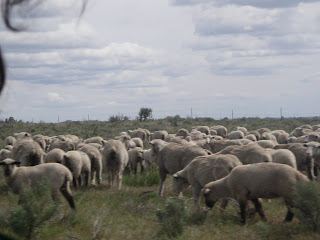 Oregon Caves
Oregon Caves is eroded out of a giant chunk of
marble, metamorphosed from limestone that was scraped off the Pacific plate. The black lines are
graphite. Only 5% of the world's caves are marble, because it's much more difficult to erode than limestone. This hardness is also why the cave is tiny compared to, say,
Carlsbad.

Water drips down through organic material on the surface, picking up carbon dioxide. This carbonic acid drips through the marble, dissolving the rock and collecting the minerals. In the hollow of the cave, the carbon dioxide dissipates, precipitating the minerals, and formations slowly grow.

One type of formation is called rimstone, or gours. These "dams" grow in areas with slow water movement and low gradients.

Back in the 1900s, people destroyed a large section of rimstone in the cave. This rimstone should stretch across the passage.

This is an empty crystal pool elsewhere in the cave. However, it is evident that the destroyed rimstone was covered with crystal.

It is certainly made out of crystal. You can see the tree-like crystal structure.

As a contrast, this is the crystal structure of flowstone.

But observing the crystal structure of these formation should be impossible, because they shouldn't be broken. This piece even has a thick layer of epoxy glued on. It makes me very glum.

But, despite the damage, there are still many cool formations in the cave.

There are also neat cave bugs, like these endemic harvestmen (which are not spiders!) In the winter, they gather inside the cave to stay warm, and occasionally do pushups (no, I'm not kidding you.) They can also self-amputate their legs, and then grow them back. All of which makes them into my favorite insect, ever.

And, on the surface, you can see fawns.




































